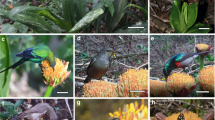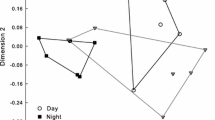Abstract
Specialized pollination by prey-hunting wasps is poorly documented in rewarding plants. Furthermore, the mechanisms of achieving specialization are not clear since flowers typically produce exposed nectar and have no morphological adaptations (such as long spurs) to exclude non-pollinating visitors. We investigated the pollination of Xysmalobium orbiculare and explored the functional roles of floral scent and nectar in attracting pollinators and deterring nectar robbers. Floral visitor observations showed that this milkweed is visited almost exclusively by pompilid wasps in the genus Hemipepsis. These wasps were the only insects to carry pollinia, and a cage experiment confirmed their effectiveness in removing and inserting pollinia on flowers. Hand-pollinations showed that plants are genetically self-incompatible and thus reliant on pollinators for seed set. Palatability experiments with honeybees showed that nectar is distasteful to non-pollinating insects and is therefore likely to play a functional role in deterring nectar thieves. Choice experiments in the field showed that the wasp pollinators are attracted primarily by floral scent rather than visual cues. Analysis of spectral reflectance of flowers revealed that flowers are dull colored and are unlikely to stand out from the background vegetation. We conclude that X. orbiculare is specialized for pollination by spider-hunting wasps in the genus Hemipepsis and utilizes floral scent to selectively attract its pollinators and unpalatable nectar to deter non-pollinating visitors.




Similar content being viewed by others
References
Adler LS (2000) The ecological significance of toxic nectar. Oikos 91:409–420
Armbruster WS (2006) Evolutionary and ecological aspects of specialized pollination: views from the arctic to the tropics. In: Waser NM, Ollerton J (eds) Plant-pollinator interactions. The University of Chicago Press, Chicago
Brodmann J, Twele R, Francke W, Holzler G, Zhang QH, Ayasse M (2008) Orchids mimic green-leaf volatiles to attract prey-hunting wasps for pollination. Curr Biol 18:740–744
Ehlers BK, Olesen JM, Agren J (2002) Floral morphology and reproductive success in the orchid Epipactis helleborine: regional and local across-habitat variation. Plant Syst Evol 236:19–32
Fenster CB, Armbruster WS, Wilson P, Dudash MR, Thomson JD (2004) Pollination syndromes and floral specialization. Ann Rev Ecol Evol Syst 35:375–403
Goyder D, Nicholas A, Liede-Schumann S (2007) Phylogenetic relationships in subtribe Asclepiadinae (Apocynaceae: Asclepiadoideae). Ann Mo Bot Gard 94:423–434
Johnson SD (2005) Specialized pollination by spider-hunting wasps in the African orchid Disa sankeyi. Plant Syst Evol 251:153–160
Johnson SD, Steiner KE (2000) Generalization versus specialization in plant pollination systems. Trends Ecol Evol 15:140–143
Johnson SD, Peter CI, Agren J (2004) The effects of nectar addition on pollen removal and geitonogamy in the non-rewarding orchid Anacamptis morio. Proc R Soc B 271:803–809
Johnson SD, Hargreaves AL, Brown M (2006) Dark, bitter-tasting nectar functions as a filter of flower visitors in a bird-pollinated plant. Ecology 87:2709–2716
Johnson SD, Ellis A, Dötterl S (2007) Specialization for pollination by beetles and wasps: the role of lollipop hairs and fragrance in Satyrium microrrhynchum (Orchidaceae). Am J Bot 94:47–55
Leimu R (2004) Variation in the mating system of Vincetoxicum hirundinaria (Asclepiadaceae) in peripherial island populations. Ann Bot 93:107–113
Lipow SR, Wyatt R (1998) Reproductive biology and breeding system of Gonolobus suberosus (Asclepiadaceae). J Torrey Bot Soc 125:183–193
Lipow SR, Wyatt R (2000) Towards an understanding of the mixed breeding system of swamp milkweed (Asclepias incarnata). J Torrey Bot Soc 127:193–199
Lipow SR, Broyles SB, Wyatt R (1999) Population differences in self-fertility in the “self-incompatible” milkweed Asclepias exaltata (Asclepiadaceae). Am J Bot 86:1114–1120
Nicholas A (1999) A taxonomic reassessment of the subtribe Asclepiadinae (Asclepiadaceae) in southern Africa. PhD Thesis, University of Durban-Westville, South Africa
Ollerton J, Johnson SD, Cranmer L, Kellie S (2003) The pollination ecology of an assemblage of grassland asclepiads in South Africa. Ann Bot 92:807–834
Ollerton J, Killick A, Lamborn E, Watts S, Whiston M (2007) Multiple meanings and modes: on the many ways to be a generalist flower. Taxon 56:717–728
Pooley E (1998) A field guide to wildflowers of KwaZulu-Natal and the eastern region. Natal Flora Publications Trust, Durban
Punzo F (2006) Plants whose flowers are utilized by adults of Pepsis grossa Fabricius (Hymenoptera: Pompilidae) as a source of nectar. J Hymenoptera Res 15:171–176
Raguso RA (2001) Floral scent, olfaction, and scent-driven foraging behaviour. In: Chittka L, Thompson JD (eds) Cognitive ecology of pollination. Cambridge University Press, Cambridge
Raguso RA (2006) Behavioural responses to floral scent: experimental manipulations and the interplay of sensory modalities. In: Dudareva N, Pichersky E (eds) Biology of floral scent. Taylor and Francis Group, Boca Raton
Schiestl FP (2005) On the success of a swindle: pollination by deception in orchids. Naturwissenschaften 92:255–264
Schiestl FP, Ayasse M, Paulus HF, Lofstedt C, Hansson BS, Ibarra F, Francke W (1999) Orchid pollination by sexual swindle. Nature 399:421–422
Schiestl FP, Peakall R, Mant JG, Ibarra F, Schulz C, Franke S, Francke W (2003) The chemistry of sexual deception in an orchid-wasp pollination system. Science 302:437–438
Shuttleworth A, Johnson SD (2006) Specialized pollination by large spider-hunting wasps and self-incompatibility in the African milkweed Pachycarpus asperifolius. Int J Plant Sci 167:1177–1186
Shuttleworth A, Johnson SD (2008) Bimodal pollination by wasps and beetles in the African milkweed Xysmalobium undulatum. Biotropica 40:568–574
Shuttleworth A, Johnson SD (2009a) Palp-faction: an African milkweed dismembers its wasp pollinators. Environ Entomol (in press)
Shuttleworth A, Johnson SD (2009b) A key role for floral scent in a wasp-pollination system in Eucomis (Hyacinthaceae). Ann Bot 103:715–725. doi:10.1093/aob/mcn261
Stephenson AG (1981) Toxic nectar deters nectar thieves of Catalpa speciosa. Am Midl Nat 105:381–383
Stephenson AG (1982) Iridoid glycosides in the nectar of Catalpa speciosa are unpalatable to nectar thieves. J Chem Ecol 8:1025–1034
Victor JE, Bredenkamp CL, Venter HJT, Bruyns PV, Nicholas A (2000) Apocynaceae. In: Leistner OA (ed) Seed plants of southern Africa: families and genera. Strelitzia 10:71–98, National Botanical Institute, Pretoria
Vieira MF, Shepherd GJ (1999) Pollinators of Oxypetalum (Asclepiadaceae) in southeastern Brazil. Rev Bras Biol 59:693–704
Wyatt R (1976) Pollination and fruit-set in Asclepias—a reappraisal. Am J Bot 63:845–851
Wyatt R, Broyles SB (1994) Ecology and evolution of reproduction in milkweeds. Ann Rev Ecol Syst 25:423–441
Acknowledgments
We thank Prof. D. Brothers for assistance with wasp identification and A.-L. Wilson for assistance in the field. J. Ollerton and an anonymous reviewer are thanked for their comments on an earlier draft of the manuscript. A. and H.M. Shuttleworth and R. Kunhardt are thanked for permission to work at Wodwo and Wahroonga farms respectively. This study was supported by the National Research Foundation of South Africa.
Author information
Authors and Affiliations
Corresponding author
Rights and permissions
About this article
Cite this article
Shuttleworth, A., Johnson, S.D. Specialized pollination in the African milkweed Xysmalobium orbiculare: a key role for floral scent in the attraction of spider-hunting wasps. Plant Syst Evol 280, 37–44 (2009). https://doi.org/10.1007/s00606-009-0171-y
Received:
Accepted:
Published:
Issue Date:
DOI: https://doi.org/10.1007/s00606-009-0171-y




